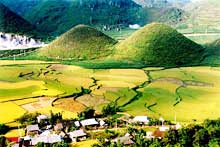With plentiful natural resources and diversified culture full of characters of 23 ethnic groups, Ha Giang is a place where may develop various types of tourism.

In order to solve harmoniously relations between preservation, protection of natural resources and tourism development, Ha Giang Tourism has defined that development of community tourism is one of methods aim to ensure development target of Ha Giang Tourism in a sustainable way. Development of this form of tourism does not require big investment, but still generates products with high attraction, preserves and restores traditional handicrafts, considerably improves people’s lives.
Speaking at the forum Community Tourism – Reality and Solutions to Sustainable Development, Vice Chairman of Ha Giang provincial People's committee Vuong Mi Vang confirmed that tourism is defined as a key economic sector of the province, in which development of community tourism is a breakthrough to efficiently exploit potentials as well as strengths of Ha Giang Tourism. In August 2006, Ha Giang provincial People’s committee promulgated the action plan No. 35/CTHĐ-UB “To build community tourism cultural villages in districts (from 2 to 3 and even more villages in each district) to raise material and spiritual living standard step by step for people". Till now, to carry out this program, 25 cultural villages with community tourism form in the whole province has been surveyed and established. The total investment capital sources for infrastructure system, technical materials has reached 6,808 million dong, in which the capital source contributed by people is 3,647 million dong. Twenty five training classes on community tourism in hamlets and mountain villages for nearly 1500 turns of people has been hold; tours have been organized in order to learn from community tourism forms in Mai Chau, Sa Pa. In 2007, some hamlets and mountain villages such as Tha, Tieng Thang mountain villages, Tuy, Buc Ban hamlets and so on welcomed and served thousands of turns of domestic and foreign tourists. Traditional handicrafts such as flax weaving, rattan, ethnic clothes become souvenirs for tourists. People in cultural villages have initially been aware of roles and actively participated in local community tourism activities. Thank to it, not only the life of local people has been considerably improved but also it has contributed to restoring traditional trade villages, cultural activities and enhancing the awareness of protecting environmental sanitation.
According to Mr. Nguyen Trung Thuong, the director of Ha Giang Culture and Information Department, community tourism development in Ha Giang has been obtained many achievements, however, some of cultural villages with community tourism form have not meet the criterion of traditional, cultural characters, and the environmental sanitation standards. Only receiving tourists and food and drink services are offered, the conditions for visitors stay overnight have been not enough yet.
To develop the community tourism in Ha Giang Province, Mr. Vu The Binh, the director of Travel Department – VNAT mentioned that some regions with outstanding tourism potentials such as Dong Van, Quan Ba, Hoang Su Phi, Xin Man, Bac Me need to be focused. A master plan as well as the details of community tourism routes and destinations with special culture and diversified ecology need to be built. At the same time, the viewpoints of sustainable tourism development need to be thoroughly complied with in order to minimize the negative effects of tourism activities on people and the environment. During the exploitation progress, the authorities and companies need to attach much importance to benefits of the local people. Ha Giang province should facilitate tourism trading enterprises by mechanisms, policies to draw investment in developing various types of friendly tourism to the environment; focus on training human resources in term of operations, skills as well as methods of environment protection, especially community in hamlets and mountain villages where tourists come; encourage the local people to maintain and preserve cultural features in life, to develop traditional handicraft villages and so on.